Dynamics and Strength of Circular Tube Open Wagons with Aluminum Foam Filled Center Sills
Abstract
1. Introduction
2. Analysis of Recent Research and Publications
3. Objective and Tasks of the Article
4. Presentation of the Basic Material of the Study
5. Conclusions
- Mathematical modeling of dynamic loads on the carrying structure of an open wagon was conducted with consideration of aluminum foam as the filler for the center sill. The aluminum foam was considered as an elastic body of the stiffness of 100 kN/m. The calculation was made in the case when the longitudinal loading on the carrying structure of an open wagon was P = 3.5 MN. The mathematical model was solved in MathCad software. The maximum accelerations on the carrying structure of an open wagon were 35.7 m/s2, which was 3.5% lower in comparison with those of the tubular structure without the filler.
- The strength of the carrying structure of an open wagon with consideration of aluminum foam as the filler for the center sill was defined by the finite element method in CosmosWorks software with SolidWorks software for the graphics. The maximum equivalent stresses emerging in the top section of the center sill behind the rear draft lugs accounted for about 320 MPa. The maximum displacements fixed in the middle part of the center sill were 9.5 mm. The maximum deformations were 3.64 × 10−3. It is established that foam aluminum applied as the filler for the center sill decreases the maximum equivalent stresses in the carrying structure of an open wagon by about 5%, and displacements by 12% in comparison with those of the circular tube carrying structure of an open wagon without filler. The mass of the carrying structure of an open wagon increases by 2.6% in comparison with that of the filler-free structure (at aluminum foam density 300 kg/m3).
- Computer modeling of the dynamic loads on the carrying structure of an open wagon was conducted with consideration of aluminum foam as filler for the center sill. The maximum accelerations emerging in the middle section of the center sill were 30 m/s2. The maximum accelerations in the side walls were concentrated in the middle sections and accounted for about 20 m/s2. The minimum accelerations were in the end parts of the carrying structure of an open wagon.
- Modal analysis of the carrying structure of an open wagon with consideration of aluminum foam as filler for the center sill was conducted. It determined the natural frequencies in the carrying structure of a flat wagon. It was established that the values of the natural oscillation frequencies do not fall outside the range of the admissible values.
- Mathematical models of the dynamic loading of the carrying structure of an open wagon with consideration of aluminum foam as filler for the center sill were verified. A F-test was used as a design criterion. Thus, the adequacy dispersion was and the error mean square was . Also, the design criterion value was Fp = 1.38, which was lower than its tabular value (Ft = 3.07). As a result, the hypothesis on adequacy was not rejected.
Author Contributions
Funding
Institutional Review Board Statement
Informed Consent Statement
Data Availability Statement
Conflicts of Interest
References
- Sága, M.; Blatnický, M.; Vaško, M.; Dižo, J.; Kopas, P.; Gerlici, J. Experimental Determination of the Manson−Coffin Curves for an Original Unconventional Vehicle Frame. Materials 2020, 13, 4675. [Google Scholar] [CrossRef]
- Sivanur, K.; Umananda, K.V.; Pai, D. Advanced materials used in automotive industry-a review. In Proceedings of the 3rd International Conference on “Advancements in Aeromechanical Materials for Manufacturing”, ICAAMM 2020, Hyderabad, India, 6–8 July 2020. [Google Scholar]
- Lee, H.A.; Jung, S.B.; Jang, H.H.; Shin, D.H.; Lee, J.U.; Kim, K.W.; Park, G.J. A design process for a railway-car body with aluminum extrusion panels using structural optimization. Civ. Comp. Proc. 2012, 98, 21. [Google Scholar]
- Hirsch, J. Aluminum in innovative light-weight car design. Mater. Trans. 2011, 52, 818–824. [Google Scholar] [CrossRef]
- Findik, F.; Turan, K. Materials selection for lighter wagon design with a weighted property index method. Mater. Des. 2012, 37, 470–477. [Google Scholar] [CrossRef]
- Campana, F.; Mancini, E.; Pilone, D.; Sasso, M. Failure Mechanisms of an Al 6061 Alloy Foam under Dynamic Conditions. Materials 2021, 14, 1349. [Google Scholar] [CrossRef]
- Costanza, G.; Tata, M.E. Mechanical behavior of PCMT and SDP Al foams: A comparison. Procedia Struct. Integr. 2020, 25, 55–62. [Google Scholar] [CrossRef]
- Dižo, J.; Blatnický, M.; Harušinec, J.; Falendysh, A. Modification and analyses of structural properties of a goods wagon bo-gie frame. Diagnostyka 2019, 20, 41–48. [Google Scholar] [CrossRef]
- Dižo, J.; Harušinec, J.; Blatnický, M. Computation of Modal Properties of Two Types of Freight Wagon Bogie Frames Using the Finite Element Method. Manuf. Technol. 2018, 18, 208–214. [Google Scholar] [CrossRef]
- Dizo, J.; Blatnicky, M.; Skocilasova, B. Computational modelling of the rail vehicle multibody system including flexible bodies. Commun. Sci. Lett. Univ. Zilina 2015, 17, 31–36. [Google Scholar]
- Stastniak, P.; Suchánek, A.; Kurčík, P.; Smetanka, L.; Moravčík, M. Driveability prediction in design process of freight wag-on underframe. In Proceedings of the 17th International Scientific Conference on Dynamics of Rigid and Deformable Bodies 2019, Usti Nad Labem, Czech Republic, 9–11 October 2019. [Google Scholar]
- Štastniak, P.; Kurčík, P.; Pavlík, A. Design of a new railway wagon for intermodal transport with the adaptable loading platform. In Proceedings of the 10th International Scientific Conference Horizons of Railway Transport, HORT 2018, Strecno, Slovakia, 11–12 October 2018. [Google Scholar]
- Šťastniak, P.; Smetanka, L.; Moravčík, M. Structural Analysis of a Main Construction Assemblies of the New Wagon Prototype Type Zans. Manuf. Technol. 2018, 18, 510–517. [Google Scholar] [CrossRef]
- Antipin, D.; Racin, D.; Shorokhov, S. Justification of a Rational Design of the Pivot Center of the Open-top Wagon Frame by means of Computer Simulation. Procedia Eng. 2016, 150, 150–154. [Google Scholar] [CrossRef]
- Shukla, C.P.; Bharti, P.K. Study and Analysis of Doors of BCNHL Wagons. Int. J. Eng. Res. 2015, V4, 1195–1200. [Google Scholar] [CrossRef]
- Harak, S.S.; Sharma, S.C.; Harsha, S.P. Structural Dynamic Analysis of Freight Railway Wagon Using Finite Element Method. Procedia Mater. Sci. 2014, 6, 1891–1898. [Google Scholar] [CrossRef]
- Fomin, O.; Lovska, A.; Radkevych, V.; Horban, A.; Skliarenko, I.; Gurenkova, O. The dynamic loading analysis of containers placed on a flat wagon during shunting collisions. ARPN J. Eng. Appl. Sci. 2019, 14, 3747–3752. [Google Scholar]
- Fomin, O.; Lovska, A. Improvements in passenger car body for higher stability of train ferry. Eng. Sci. Technol. Int. J. 2020, 23, 1455–1465. [Google Scholar] [CrossRef]
- Vatulia, G.; Komagorova, S.; Pavliuchenkov, M. Optimization of the truss beam. Verification of the calculation results. In Proceedings of the 7th International Scientific Conference “Reliability and Durability of Railway Transport Engineering Structures and Buildings” (Transbud-2018), Kharkiv, Ukraine, 14–16 November 2018. [Google Scholar]
- Bain, D.G. Analysis of stress condition of the runner of floor of the eight-wheel gondola car. J. Vestn. BSTU 2011, 1, 47–51. [Google Scholar]
- Lee, H.; Jung, S.; Jang, H.; Shin, D.; Lee, J.U.; Kim, K.W.; Park, G. Structural-optimization-based design process for the body of a railway vehicle made from extruded aluminum panels. J. Rail Rapid Transit 2016, 11. [Google Scholar] [CrossRef]
- Jang, H.J.; Shin, K.B.; Han, S.H. A study on the lightweight design of hybrid modular caibody structures made of sandwich composites and aluminum extrusions using optimum analysis method. Trans. Korean Soc. Mech. Eng. 2012, 36, 1335–1343. [Google Scholar] [CrossRef]
- Fuganti, A.; Lorenzi, L.; Grønsund, A.; Langseth, M. Aluminum foam for automotive applications. Adv. Eng. Mater. 2000, 2, 200–204. [Google Scholar] [CrossRef]
- Konyukhov, A.D.; Zhuravleva, L.V.; Shurtakov, A.K. Extruded aluminum panels—Perspective material for wagon bodies. Wagons Carriage Facil. 2007, 2, 36–38. [Google Scholar]
- Rahimov, R.V.; Ruzmetov, Y.O. Analysis of the state and prospects of the development of the freight wagon fleet of the Republic of Uzbekistan. Non-Ferr. Met. 2018, 44, 7–11. [Google Scholar] [CrossRef]
- DSTU 7598:2014. Freight Wagons. General Requirements for Calculations and Design of New and Modernized Wagons of 1520 mm Track (Non-Self-Propelled); UkrNDNTS: Kiev, Ukraine, 2015; 162p. [Google Scholar]
- Papantoniou, I.; Pantelis, D.; Manolakos, D. Powder metallurgy route aluminium foams: A study of the effect of powder morphology, compaction pressure and foaming temperature on the porous structure. Procedia Struct. Integr. 2018, 10, 243–248. [Google Scholar] [CrossRef]
- GOST 33211-2014. Freight Wagons. Requirements for Strength and Dynamic Properties; FGUP “STANDARTINFORM”: Moskow, Russia, 2016; 54p. [Google Scholar]
- Fomin, O.; Lovska, A. Establishing patterns in determining the dynamics and strength of a covered freight car, which exhausted its resource. East. Eur. J. Enterp. Technol. 2020, 6, 21–29. [Google Scholar] [CrossRef]
- Fomin, O.; Kulbovsky, I.; Sorochinska, E.; Sapronova, S.; Bambura, O. Experimental confirmation of the theory of implementation of the coupled design of center girder of the hopper wagons for iron ore pellets. East. Eur. J. Enterp. Technol. 2017, 5, 11–18. [Google Scholar] [CrossRef][Green Version]
- Plakhtii, O.; Tsybulnyk, V.; Nerubatskyi, V.; Mittsel, N. The analysis of modulation algorithms and electromagnetic processes in a five-level voltage source inverter with clamping diodes. In IEEE International Conference on Modern Electrical and Energy Systems (MEES); IEEE: Piscataway Township, NJ, USA, 2019; pp. 294–297. [Google Scholar]
- Alyamovsky, A.A. SolidWorks/COSMOSWorks 2006–2007. Finite Element Analysis; DMK-Press: Moskow, Russia, 2007; 784p. [Google Scholar]
- Alyamovsky, A.A. COSMOS Works. Fundamentals of Structural Strength Analysis in SolidWorks; DMK-Press: Moskow, Russia, 2010; 785p. [Google Scholar]
- Lukin, V.V.; Shadur, L.A.; Koturanov, V.I.; Khokhlov, A.A.; Anisimov, P.S. Design and Calculation of Wagons, 2nd ed.; UMC ZhDT: Moscow, Russia, 2000; 731p. [Google Scholar]
- Kondratiev, A.; Gaidachuk, V.; Nabokina, T.; Tsaritsynskyi, A. New possibilities in creating of effective composite size-stable honeycomb structures designed for space purposes. Adv. Intell. Syst. Comput. 2020, 1113, 45–59. [Google Scholar]
- Lovska, A.; Fomin, O. A new fastener to ensure the reliability of a passenger coach car body on a railway ferry. Acta Poly-Tech. 2020, 60, 478–485. [Google Scholar]
- EN 12663–2. Railway Applications—Structural Requirements of Railway Vehicle Bodies—Part 2: Freight Wagons. B; BDS: Sofia, Bulgaria, 2010; 54p. [Google Scholar]
- Fomin, O. Modern requirements to carrying systems of railway general-purpose gondola cars. Sci. Tech. J. 2014, 5, 31–43. [Google Scholar]
- Lovska, A.O. Computer simulation of wagon body bearing structure dynamics during transportation by train ferry. East. Eur. J. Enterp. Technol. 2015, 3, 9–14. [Google Scholar]
- Plakhtii, O.; Nerubatskyi, V.; Sushko, D.; Ryshchenko, I.; Tsybulnyk, V.; Hordiienko, D. Improving energy characteristics of ac electric rolling stock by using the three-level active four-quadrant rectifiers. East. Eur. J. Enterp. Technol. 2019, 4, 6–14. [Google Scholar] [CrossRef]

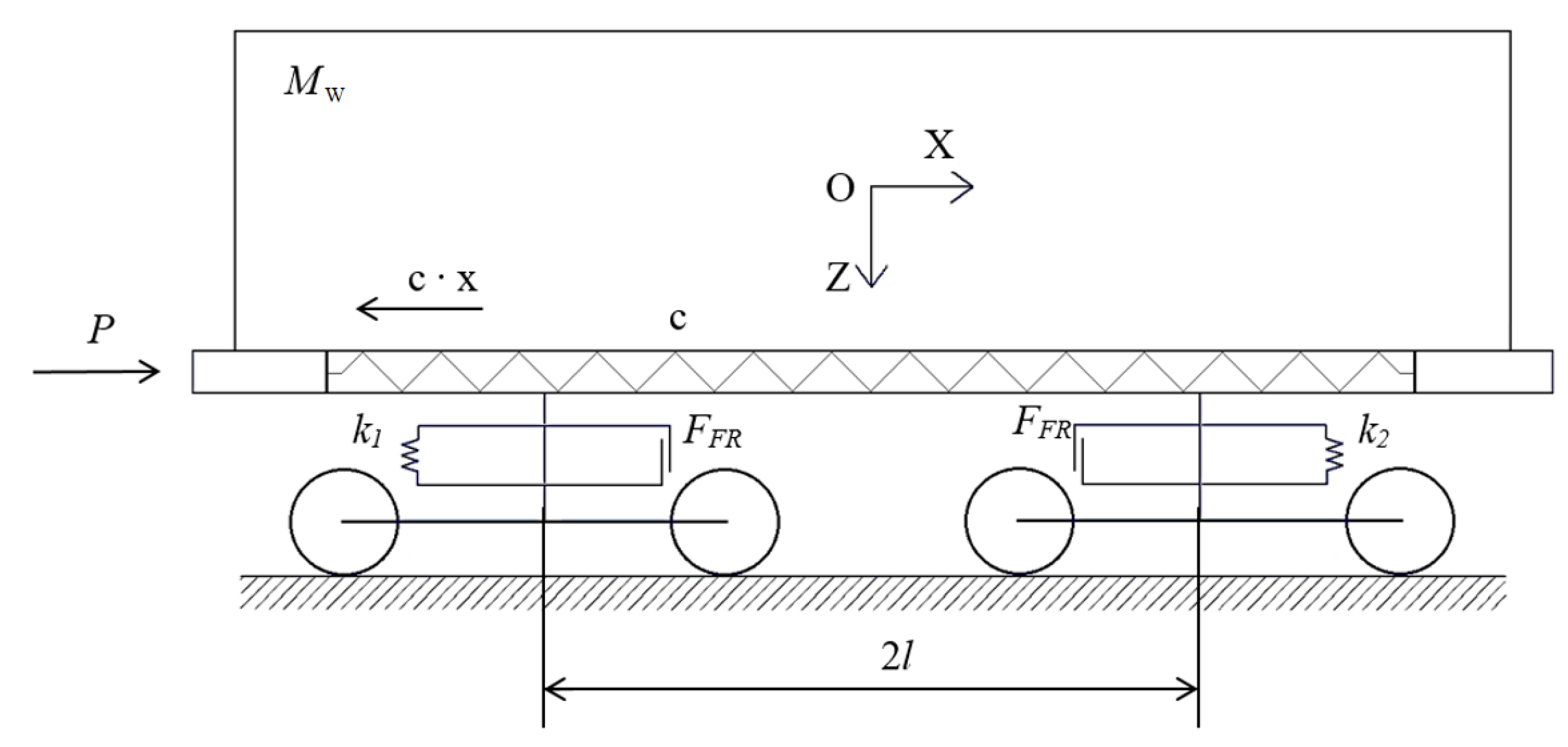

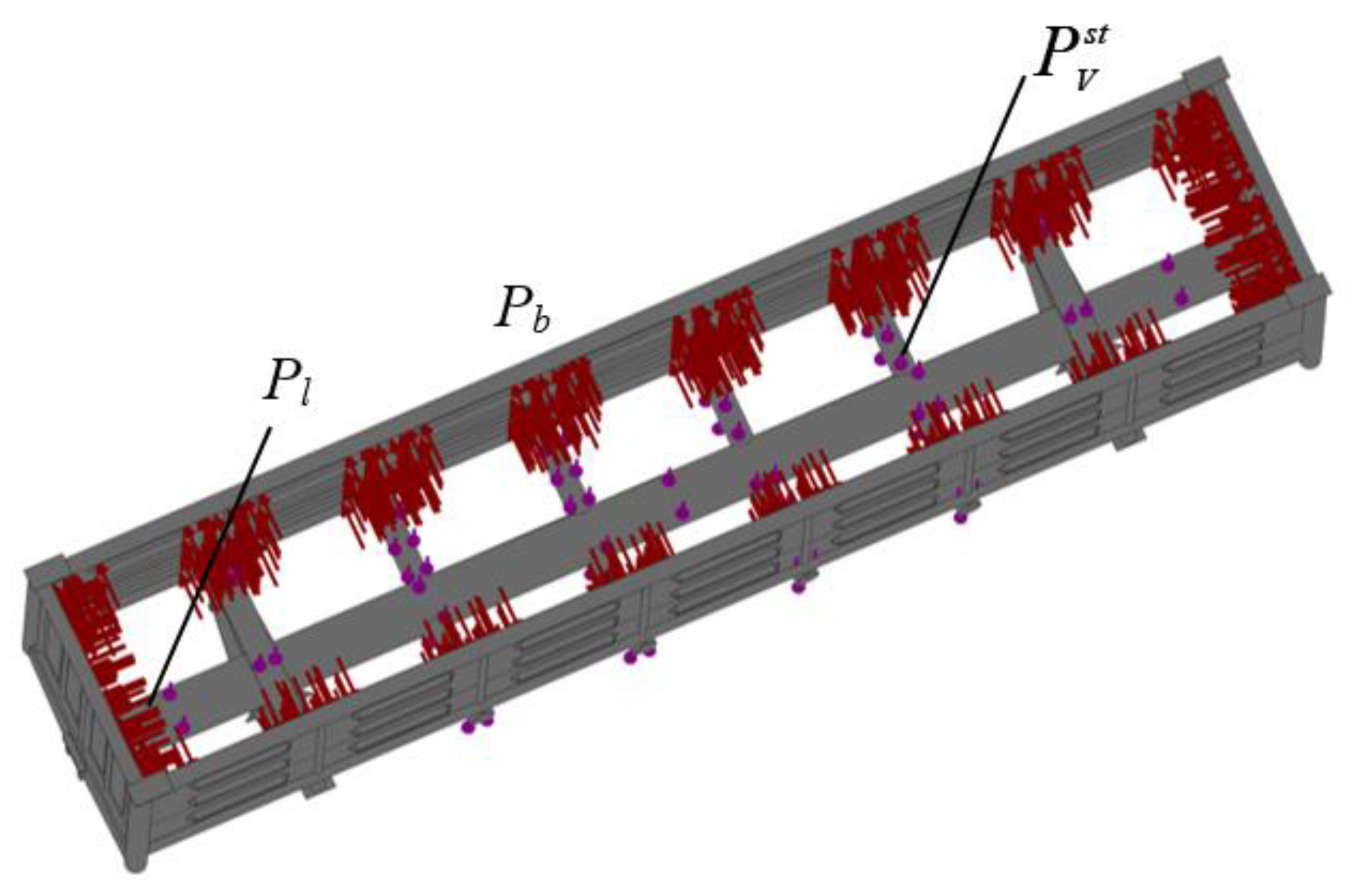
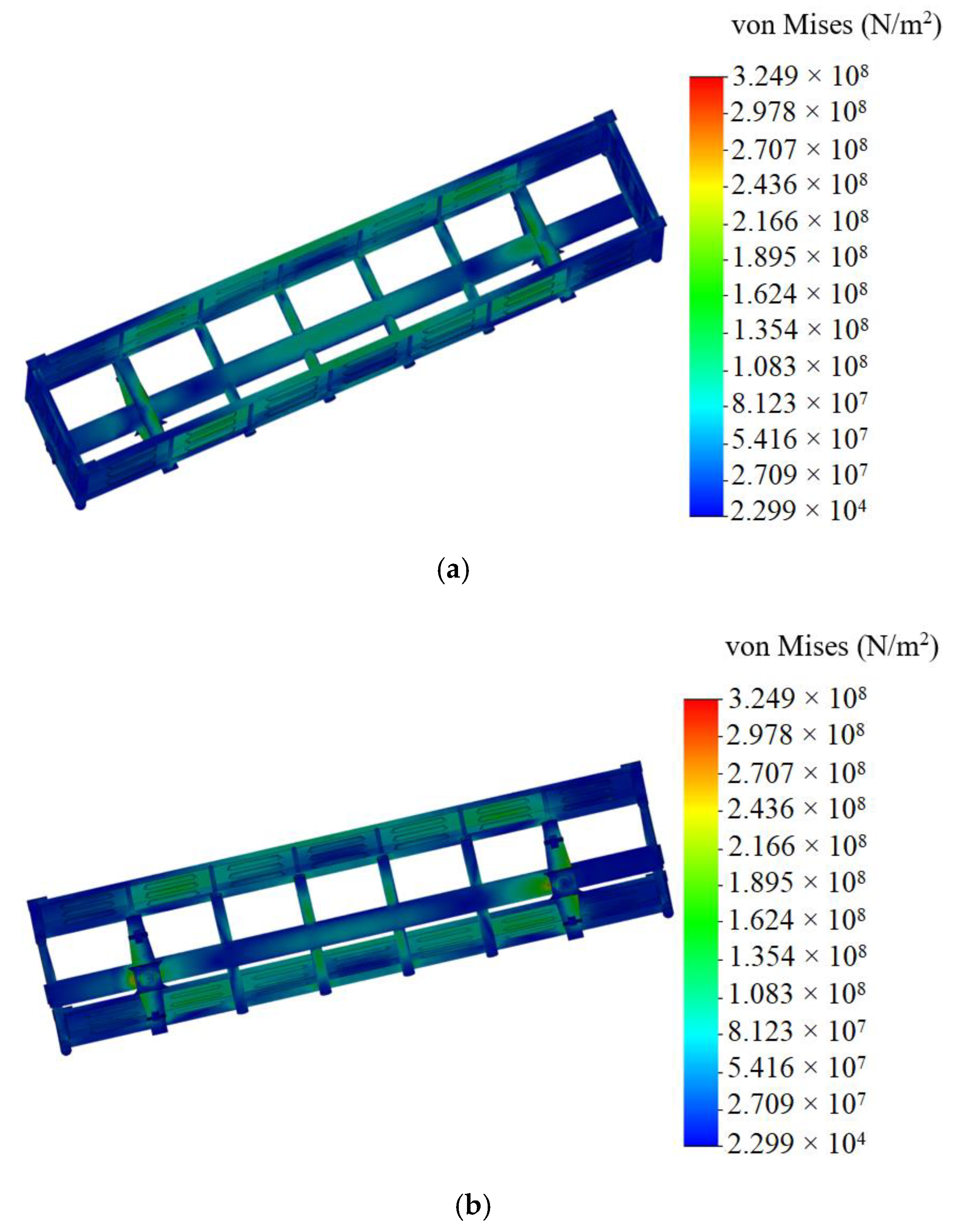

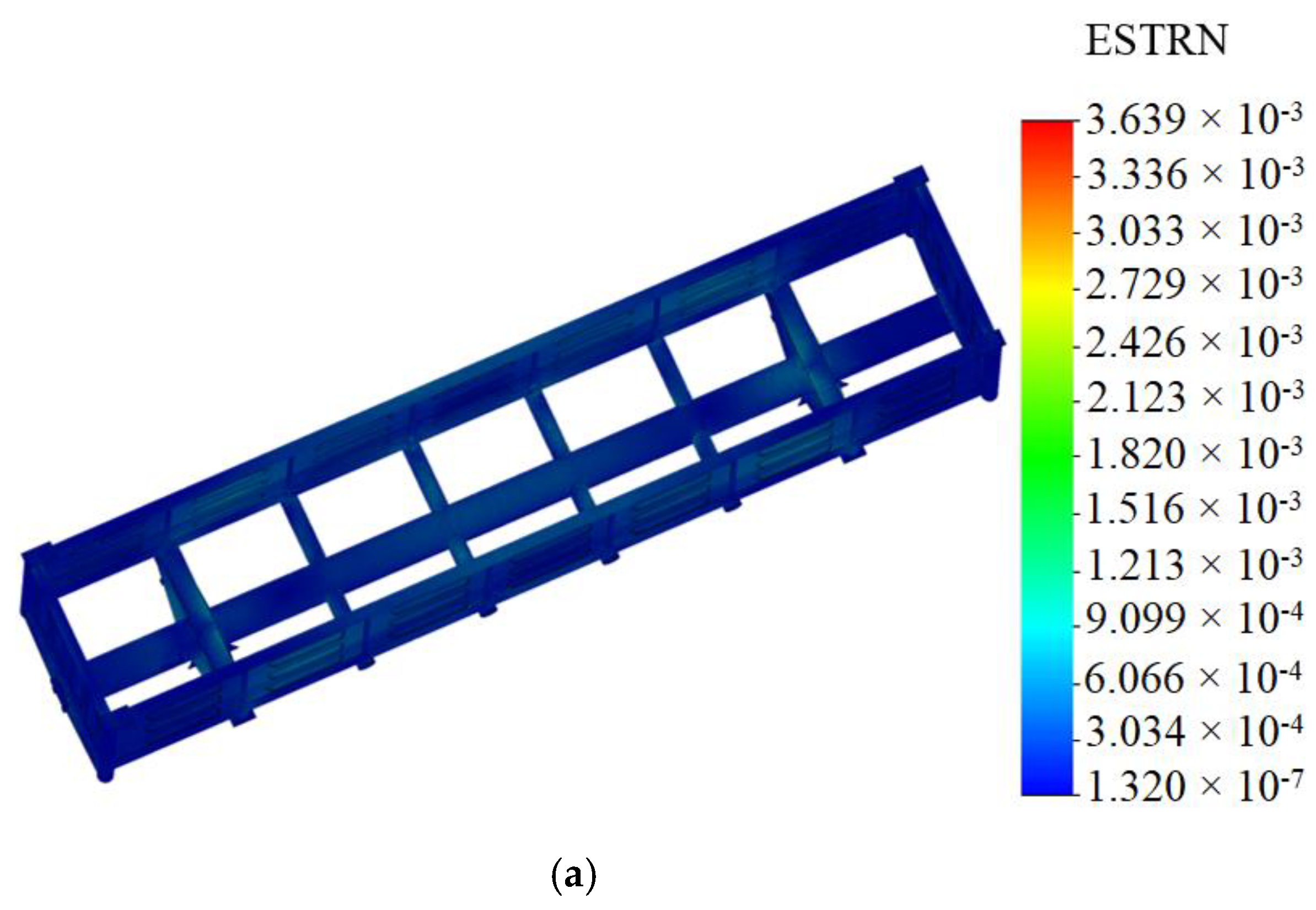
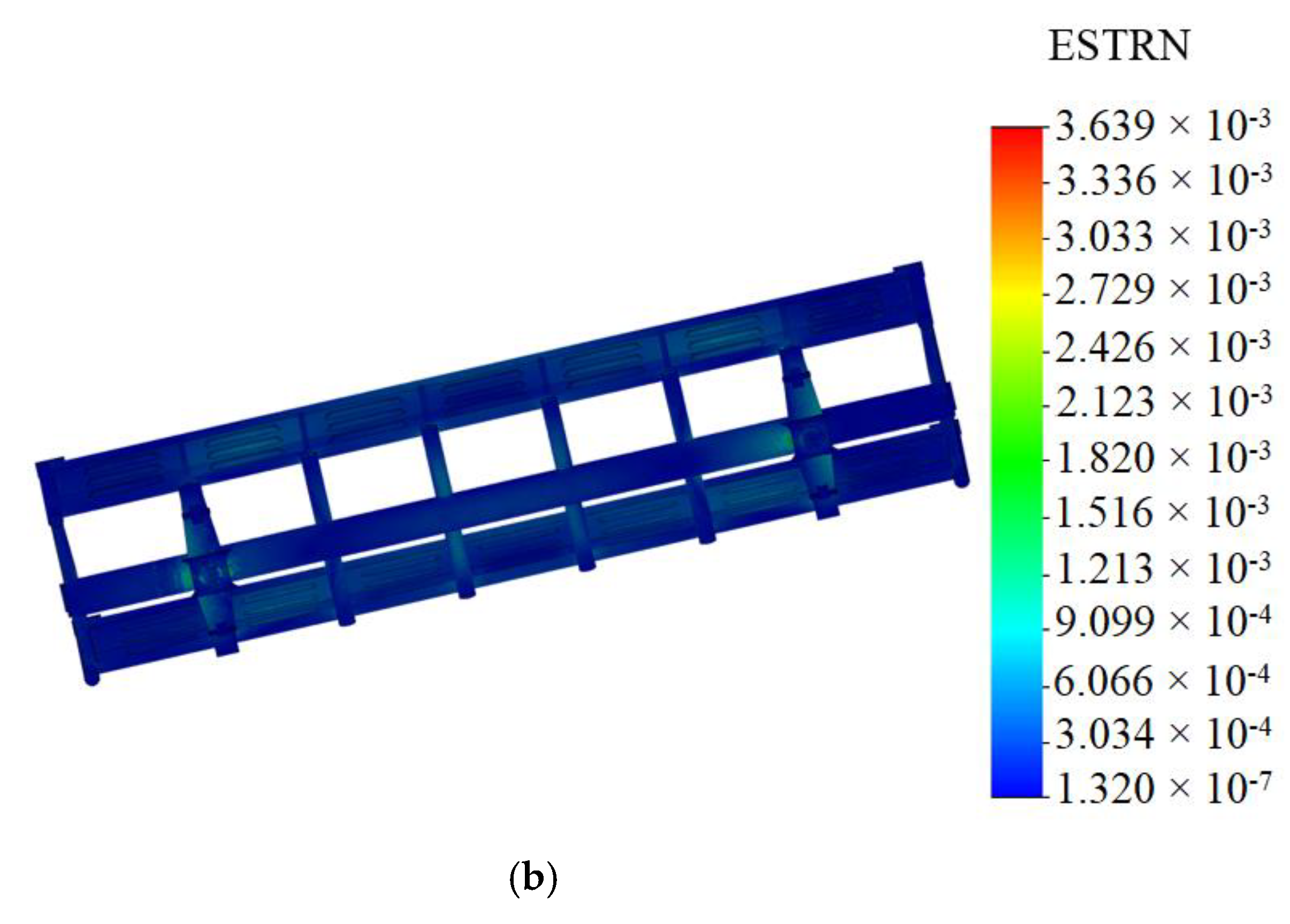
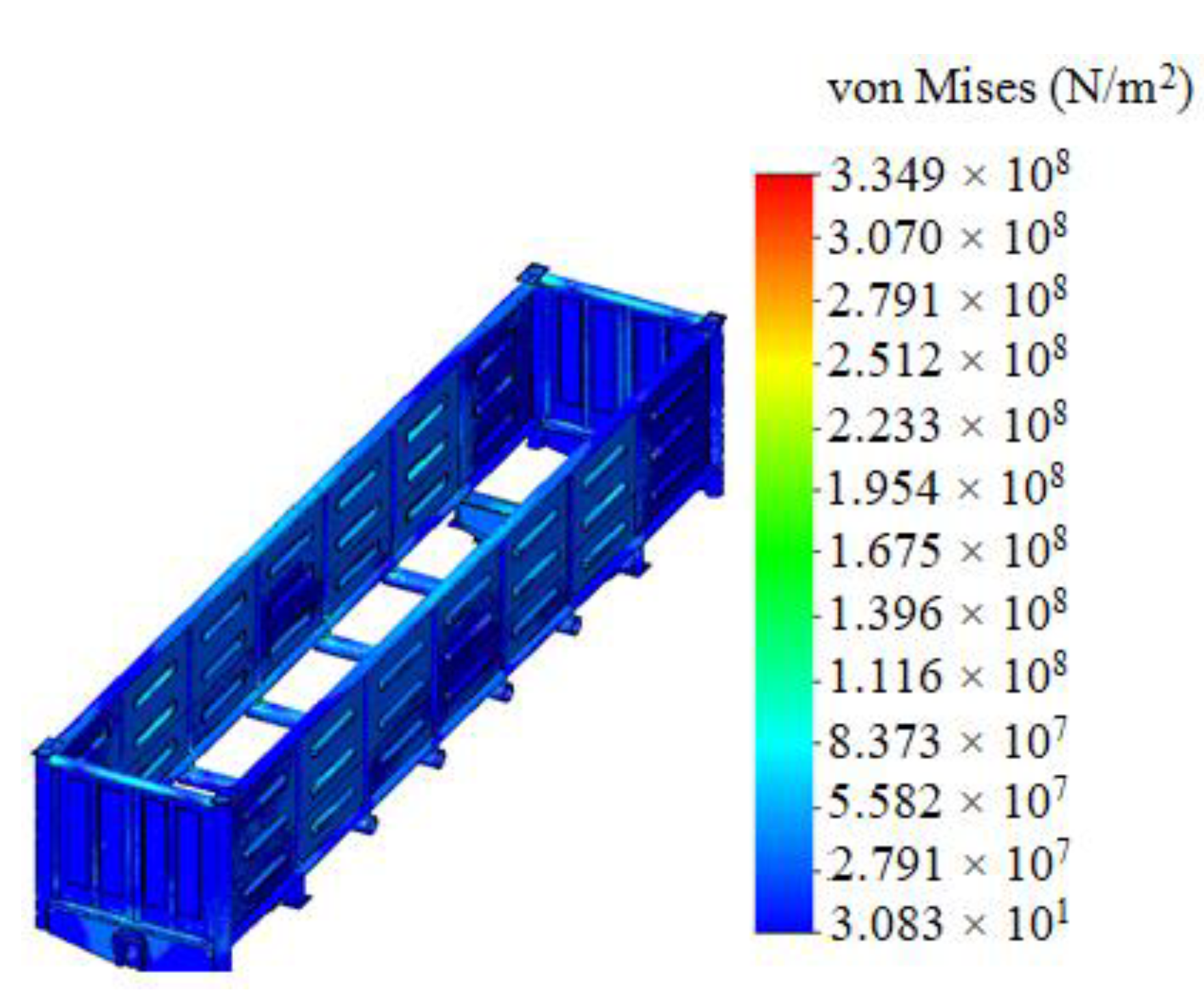
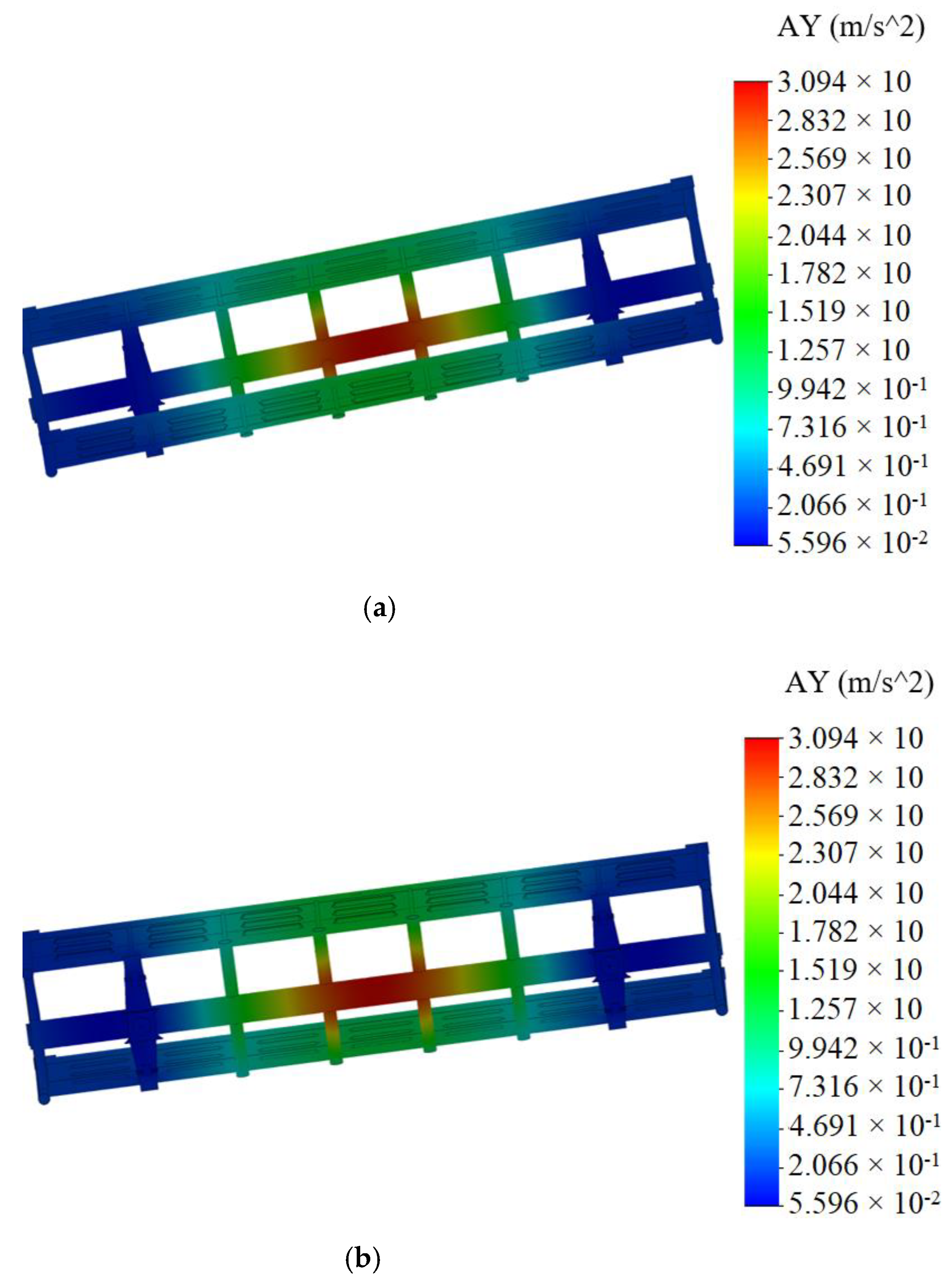
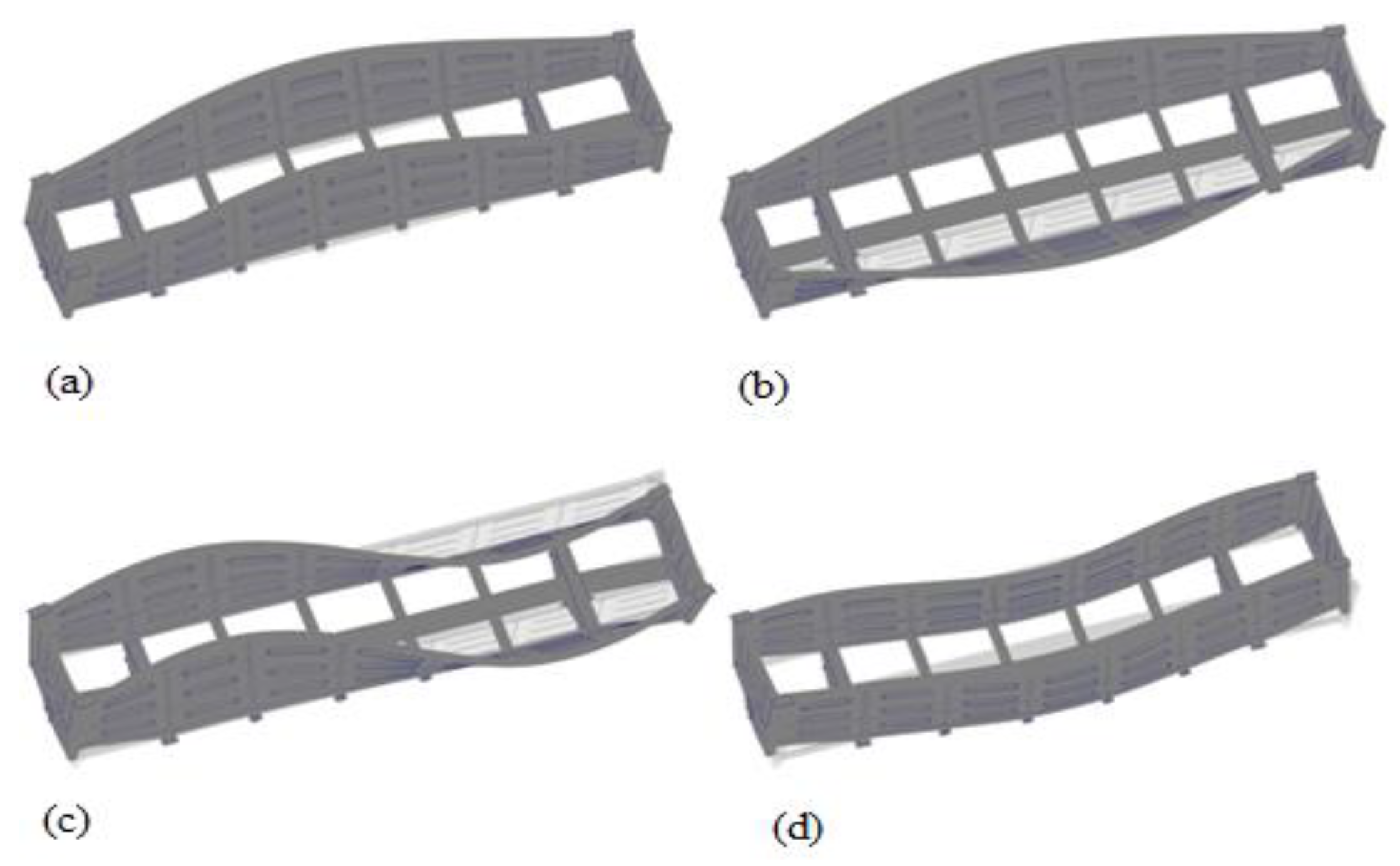
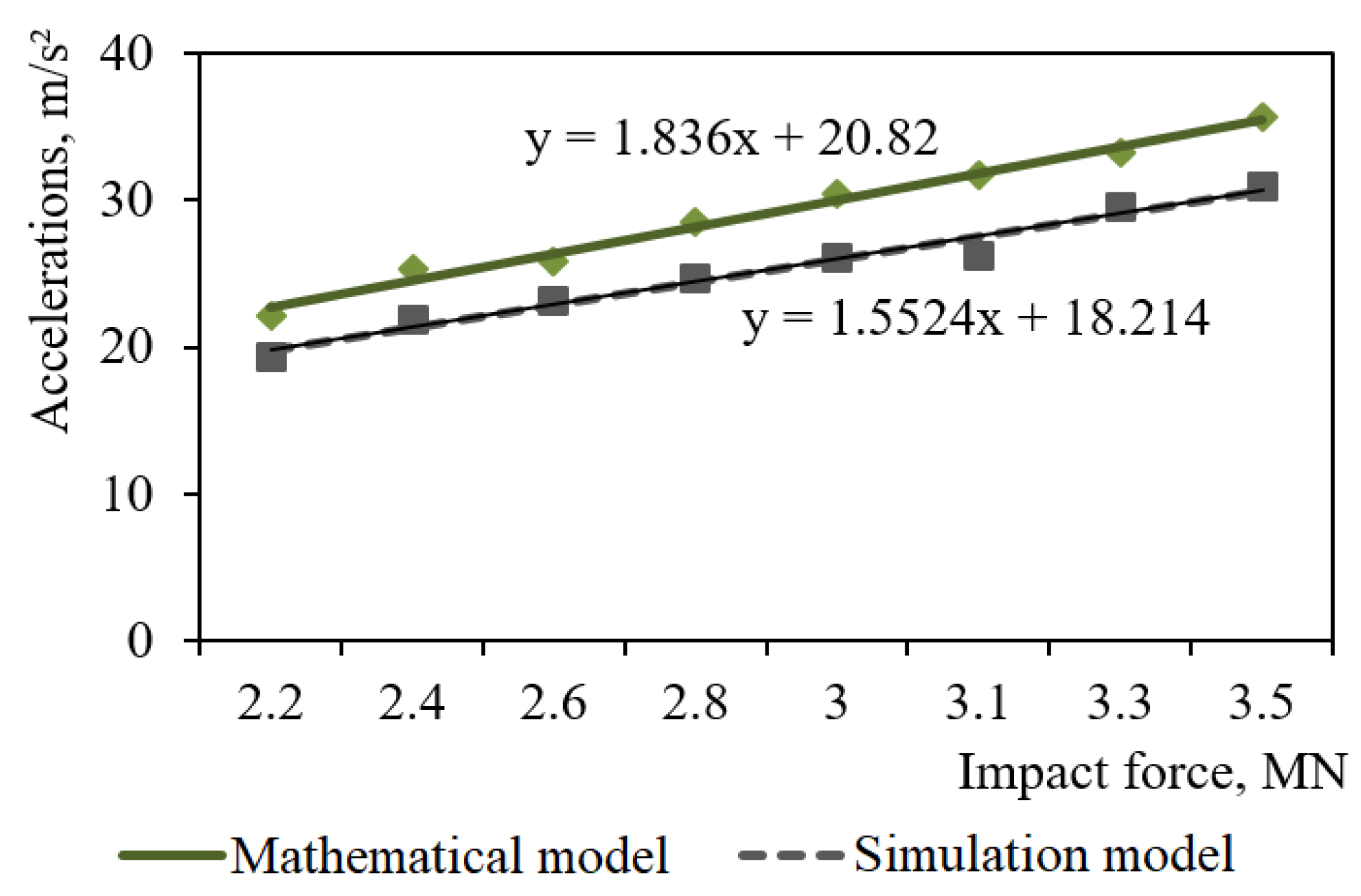
| Oscillation Mode | Frequency, Hz | Period, s |
|---|---|---|
| 1 | 18.6 | 0.051 |
| 2 | 19.5 | 0.041 |
| 3 | 30.9 | 0.038 |
| 4 | 32.3 | 0.034 |
| 5 | 33.9 | 0.033 |
| 6 | 40.3 | 0.032 |
| 7 | 44.0 | 0.031 |
| 8 | 48.3 | 0.030 |
| 9 | 53.3 | 0.027 |
| 10 | 55.2 | 0.025 |
Publisher’s Note: MDPI stays neutral with regard to jurisdictional claims in published maps and institutional affiliations. |
© 2021 by the authors. Licensee MDPI, Basel, Switzerland. This article is an open access article distributed under the terms and conditions of the Creative Commons Attribution (CC BY) license (https://creativecommons.org/licenses/by/4.0/).
Share and Cite
Fomin, O.; Gorbunov, M.; Lovska, A.; Gerlici, J.; Kravchenko, K. Dynamics and Strength of Circular Tube Open Wagons with Aluminum Foam Filled Center Sills. Materials 2021, 14, 1915. https://doi.org/10.3390/ma14081915
Fomin O, Gorbunov M, Lovska A, Gerlici J, Kravchenko K. Dynamics and Strength of Circular Tube Open Wagons with Aluminum Foam Filled Center Sills. Materials. 2021; 14(8):1915. https://doi.org/10.3390/ma14081915
Chicago/Turabian StyleFomin, Oleksij, Mykola Gorbunov, Alyona Lovska, Juraj Gerlici, and Kateryna Kravchenko. 2021. "Dynamics and Strength of Circular Tube Open Wagons with Aluminum Foam Filled Center Sills" Materials 14, no. 8: 1915. https://doi.org/10.3390/ma14081915
APA StyleFomin, O., Gorbunov, M., Lovska, A., Gerlici, J., & Kravchenko, K. (2021). Dynamics and Strength of Circular Tube Open Wagons with Aluminum Foam Filled Center Sills. Materials, 14(8), 1915. https://doi.org/10.3390/ma14081915








